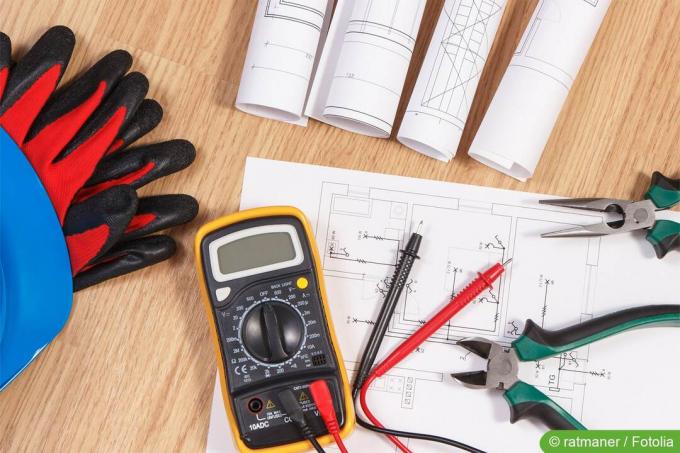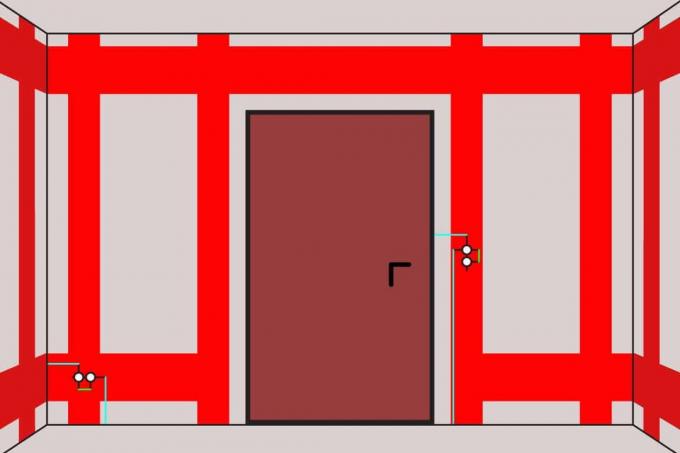

Table of contents
- House connection
- low-voltage technology
- cable in the garden
- Correct cables, connectors and connections
- Precautions
- cable costs
Save money with the house connection, illuminate the garden or connect the sauna heater to the power supply? There are many reasons to lay an underground cable. However, in this work, depending on the type of connections and the amperage, certain laying depths and connections must be taken into account. What is important in each case, we reveal here step by step.
House connection
When building your own home, you can install the house connection yourself to save costs. When laying the cables, proceed as follows:
- The type of connection and cables must be determined by an electrician. He also makes the connection himself and can provide information on the type and depth of laying.
- The ditch itself can be gutted. A depth of 60 to 80 centimeters is usually sufficient for the cables. Rocks, roots, and other large debris must be removed to avoid damage from them.
- The trench is provided with a ten centimeter deep layer of sand.
- Depending on the cable and the recommendation, the cable can now be routed through a cable protection tube or laid directly on the sand.
- If a cable cover hood is chosen instead of a cable protection tube, the hood is placed over the cable and pressed lightly into the sand. The cover can be made of clay or PVC.
- A “Warning” is placed on the cover or pipe. This can be a red and white striped construction site tape or a yellow PVC tape with the inscription "Erdkabel". It is important that it is immediately apparent when digging, thus reducing the risk of damage.
- Another layer of sand, which in turn should be about ten centimeters thick, comes over the protective tube or the cover. After that, the trench can be filled with soil.
Even if you dig the trench and lay the cable yourself, you often have to pay a flat fee. The costs usually amount to a few hundred euros. A previous cost comparison can provide information as to whether the self-service is really worthwhile in terms of price.
To dig the trench, for example, not only the corresponding working hours but also the rental of a mini excavator must be planned. Nevertheless, flat rates apply despite the personal contribution. Especially with larger trench lengths, it may only be slightly cheaper or similarly expensive to write to the deed yourself.
low-voltage technology
For the light in the garden or the pump in the pond, it does not necessarily have to be a lot of effort. So-called low-voltage technology is sufficient here. A corresponding transformer is housed in the house or garage and a line is laid from here to the destination. The cables can be laid directly underground. All you have to do is ensure that they do not get in the way when digging up the garden or are protected from damage. Again, cable hoods or alternatively a cable protection tube can be useful.
The advantages of the low-voltage technology lie on the one hand in the low risk and on the other hand in the low effort involved in laying. Since only little current flows through the cables, they are less dangerous. Due to the low laying depth, the effort is kept within narrow limits even with longer laying distances. However, the basic procedure does not differ significantly from the sequence of steps described above.
That means:
- Dig a trench and remove foreign objects such as stones and roots.
- If possible, line the trench with a layer of sand.
- Store the cable in the cable protection pipe or apply a cable cover after laying it.
- Mark the cover and cover with sand.
- Fill the trench with soil and slightly compact the soil layer.
Tip:
For future digging or other interventions in the garden, it can help to draw the location or the course of the underground cable on a plan.
cable in the garden

The low-voltage technology is not sufficient for garden sockets or the operation of larger devices, such as a sauna oven. Regular cables have to be laid here, just like with the house connection.
The procedure is the same as when laying the underground cable for the house connection. This also applies to the laying depth and advice from an electrician.
Correct cables, connectors and connections
When planning to run a cable underground, there are generally a number of factors to consider.
This includes:
-
Connections and advice from professionals
An electrician makes the connection to the fuse box and installs a residual current circuit breaker. He can also advise on what type of cable can be used and how deep the installation should be. It also provides information about applicable regulations. -
cable type
Not every cable is suitable for outdoor use and laying underground. NYY-J, NYCWY or NAYY cables are suitable because they have a special sheath. -
links
Simple couplings that are only protected against splashing water are not sufficient for laying cables underground. Water-protected plug connections must be used. Other connections and connections, for example to a garden socket, are best done by an electrician.
Precautions
It goes without saying that no current should flow through the cables when handling them. In addition, care should be taken not to damage the cables.
In addition, the advice and, if necessary, some tasks should be carried out by an electrician. This prevents serious errors from occurring.
cable costs
Cable costs start at just one euro per meter. The thicker the cable, the higher the prices. Normally, however, they remain in the single-digit euro range per meter.
At least 100 euros are due for the connections and advice from the electrician. For garden sockets, you have to calculate with 40 euros per piece. Cable ducts and covers are available from just over one euro per meter.
 Home editorial office
Home editorial office
Learn more about power/electrics

Electric roller shutters no longer go up: what to do?
If you have electric roller shutters, you wouldn't want to be without them. It is all the more annoying when the technology goes on strike and the roller shutters no longer go up. You don't always have to call in an expert. This article explains how to fix errors yourself with a little skill.

Balcony power plant 800, 1000, 1200 watts: what is allowed?
In times of energy crisis and energy transition, solar panels on the balcony offer an easy way to generate and use sustainable electricity. We explain what is behind the so-called balcony power plants and how many watts are allowed during operation.

Fault location: how do I find the defect in the cable?
If a cable in the house or apartment is defective, you usually only notice it because some electrical devices are no longer working. Then you should start looking for the error. Exactly how this fault location works is explained here.

16 ampere fuse: how many sockets / watts possible?
A 16 amp fuse is used in most households. But how many sockets or consumers and how many watts are permitted with them? We show how the maximum load can be calculated and what else needs to be taken into account.

Drilling holes for sockets: dimensions and distances
With the right tool, drilling holes for sockets is no problem. Important: distances should be maintained to the nearest millimeter if possible. Precise work is therefore of particular importance when making a hole for the socket. You'll find more about it here.

Lay TV cable and satellite cable | 5 tips for good reception
In order to lay TV and satellite cables, some prior knowledge of the subject is required. In addition, the user should rely on good quality for the cables. Otherwise, the devices to be connected cannot work properly and poor picture quality will result.



